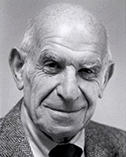David Shemin

Annually, the Major in Biological Sciences considers students for the David Shemin Prize for Basic Research.
David Shemin, a biochemist, was born March 18, 1911 at New York City, the son of Louis and Mary (Bush) Shemin. Shemin left a position at Columbia to join the faculty of Northwestern University, where he remained for the rest of his career. Shemin was an internationally recognized scientist. Shemin's research interests focused on the structure, function and mechanisms of enzymes, biosynthesis of porphyrins, protein structure, and the molecular aspects of human genetic diseases. He died in 1991.
Attending the City College of New York, Shemin majored in chemistry and biology and took his B.S. degree in 1932. He received his A.M. in chemistry in 1933 and his Ph.D. in biochemistry in 1938. Columbia University awarded both degrees.
Shemin began his career as a scientist in 1940 with an instructorship in pathology at Columbia's College of Physicians and Surgeons. His research centered on immunology and the chemistry of the Rous sarcoma virus. Shemin accepted appointment as assistant professor of biochemistry at Columbia in 1945, associate professor in 1949, and professor in 1953. He left Columbia to take a position as professor of biochemistry at Northwestern University. Shemin remained on the Northwestern faculty for the rest of his career and was appointed professor emeritus in 1979. At Northwestern Shemin served from 1974 through 1979 as the first chairman of the newly-created Department of Biochemistry and Molecular Biology. Between 1975 and 1987 he was the Deputy Director for Basic Sciences at the Northwestern Cancer Center.
Shemin's research interests focused on the structure, function and mechanisms of enzymes, biosynthesis of porphyrins, protein structure, and the molecular aspects of human genetic diseases. His work with isotopes in biochemical research, tracing the pathways through which the body produces constituent components, was pathbreaking. In a celebrated 1946 experiment Shemin ingested glycine containing the isotope of nitrogen 15N to trace the isotope's progress through his own bloodstream. The experiment contributed to a better understanding of blood compounds, their formation and degradation.
Shemin was an internationally recognized scientist. He worked at Stockholm's Karolinska Institute in 1947, took up residence at the Pasteur Institute in Paris in 1958-1959, and served at the Weitzmann Institute, Rehovoth, Israel, during the early 1970s. The Japanese Society for the Promotion of Sciences sponsored his exchange professorship in Japan in 1975. Shemin was honored by election to the National Academy of Sciences in 1958 and to the American Academy of Arts and Sciences in 1961. He was a Pasteur Medalist (1951), a recipient of Columbia University's Stevens Award (1952), Harvey Society Lecturer (1955), Guggenheim Fellow (1956, 1970), an honorary member of the Swiss Biochemical Society (1958), a Commonwealth Fellow (1965), a Fogarty International Scholar (1979-1985), a Townsend Harris Medal winner (City College of New York, 1982), a Rockefeller Foundation fellow (1987), and an honorary member of the Japanese Biochemical Society. Shemin was a member of the Marine Biological Laboratory at Woods Hole, Massachusetts, and was an invited lecturer at a number of seminars, symposia and universities including the International Congress of Biochemistry (1955), the University of Illinois (William Albert Noyes Lecture, 1956), Oak Ridge National Laboratory, Brookhaven National Laboratory, and the Royal Society of London. He was a member of many panels of the National Institutes of Health and the National Science Foundation. Shemin edited the Journal of Biological Chemistry between 1960 and 1965. His own published articles number over one hundred.
Shemin married Mildred B. Sumpter in 1937 and the couple had two children: Louise (b. 1944) and Elizabeth (b. 1949). Mildred Shemin died in 1962. In 1963 Shemin married Charlotte Norton. After retirement the Shemins moved in 1981 to Woods Hole. David Shemin died there on November 26, 1991.
Biography from Northwestern Library.
Image from the National Academy of Sciences.
